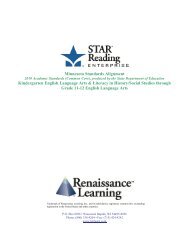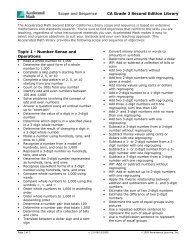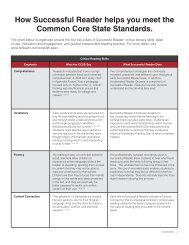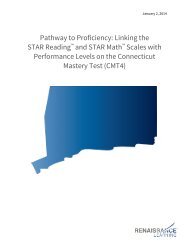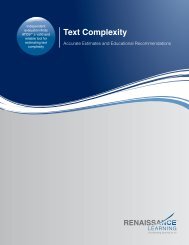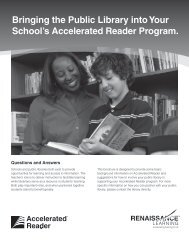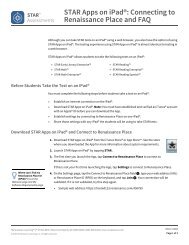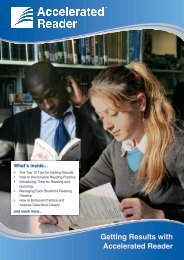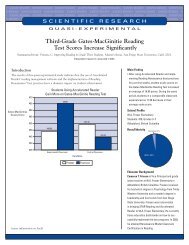Technical Manual - Renaissance Learning
Technical Manual - Renaissance Learning
Technical Manual - Renaissance Learning
Create successful ePaper yourself
Turn your PDF publications into a flip-book with our unique Google optimized e-Paper software.
ValidityPost-Publication Study Datawhich indicated that at each measurement occasion, the higher grade scoredsignificantly higher than the lower grade.An interesting phenomenon was noted when evaluating the differences betweenspring scores of one school year on STAR Early Literacy and the next higher gradelevel’s fall scores on STAR Early Literacy: fall scores for the next higher grade wereslightly lower than spring scores for the preceding grade. For instance, the averagescale score of about 615 at the end of kindergarten (spring) is about one pointhigher than the average of first grade students’ scores at the beginning of theschool year (fall). A larger difference is seen between the average spring first gradescale score of about 745 and the fall second grade average of about 725. This doesnot necessarily invalidate claims of developmental validity, because the drop inscores coincides with the occurrence of summer break. This summer break fromschool has been identified with regression in student scores between grades(Allington & McGill-Franzen, 2003; Bracey, 2002; Malach & Rutter, 2003;McGill-Franzen & Allington, 2003). The drop in scores between grade levels isconsistent with the research just cited; that is, it does not necessarily represent aninversion or discontinuity in measurement, but rather an empirical phenomenonsometimes referred to as the summer slump.Table 28 displays correlations among STAR Early Literacy test scores at differentoccasions, and of STAR Early Literacy test scores with STAR Reading scores. STAREarly Literacy-STAR Reading correlations corrected for measurement error(Crocker & Algina, 1986) are also included.STAR Early Literacy scores taken during the fall measurement point at thebeginning of the school year are significantly predictive of STAR Early Literacyscores at both the winter and spring measurement occasions. Similarly, the winterassessment was significantly predictive of the spring assessment. This indicatesthat early literacy scores within a school year are highly predictive of later scores.In addition, the STAR Early Literacy scores at each occasion were moderately tohighly related to reading scores two years after the original assessment occasion.These results are consistent for each of the subgroups partitioned by initial gradelevel.STAR Early Literacy<strong>Technical</strong> <strong>Manual</strong>75





